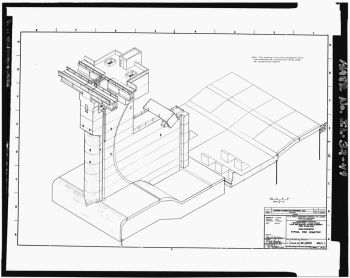Structural: Difference between revisions
No edit summary |
No edit summary |
||
| Line 22: | Line 22: | ||
* [[Structural Surveillance & Monitoring]] | * [[Structural Surveillance & Monitoring]] | ||
* [[Remotely Operated Vehicle Inspection]] | |||
<!-- For information on notation for in text citations visit https://www.mediawiki.org/wiki/Help:Cite Or simply enclose the citation as shown <ref> citation </ref> in the location of the in text mention. Citations will automatically populate below--> | <!-- For information on notation for in text citations visit https://www.mediawiki.org/wiki/Help:Cite Or simply enclose the citation as shown <ref> citation </ref> in the location of the in text mention. Citations will automatically populate below--> | ||
Latest revision as of 20:53, 13 February 2025

|
| Spillway pier isometric drawing.
(Image Source: USACE) |
Structural engineering is important in many facets of dam safety. There are a variety of forces against which a dam should be designed to adequately resist including but not limited to: self-weight, static water pressures, wave pressures, sediment buildup pressures, uplift water pressures, wind pressures, thermal loads, ice pressures, and earthquake forces. First and foremost, structural engineers must design the dam to be globally stable (particularly for concrete and masonry type dams; for embankment dams, slope stability is a separate issue). In addition to the global stability of a dam, structural engineers must also design the many appurtenant structures associated with dams to be structurally sound. These structures include spillways, intake towers, outlet conduits, gates, and more. Materials used in the construction of dams include "earth, rock, tailings from mining or milling, concrete, masonry, steel, timber, miscellaneous materials (such as plastic or rubber) and any combination of these materials." [1] Regardless of the material or combination of materials used, dams and their appurtenances must be designed to be structurally stable and meet applicable design criteria.
Structural Design Criteria
Structural Monitoring
Citations:
- ↑ ASDSO, 2022
Revision ID: 8181
Revision Date: 02/13/2025
